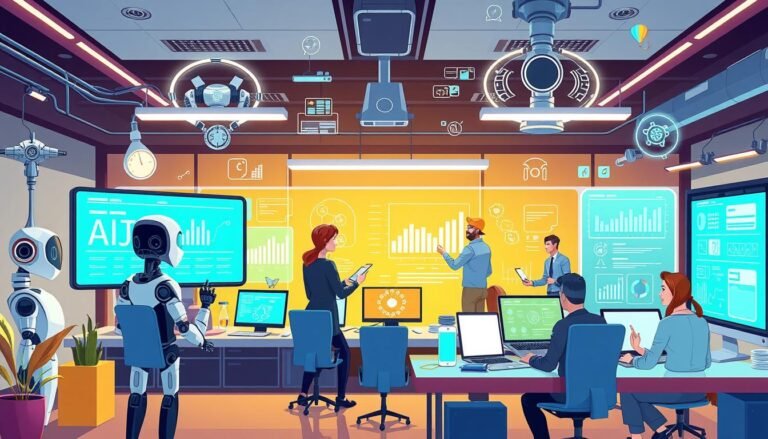Monetizing AI for Online Video Game Development
The video game industry is growing fast, with high competition and rising costs. Now, a new way to make money has come up: using Artificial Intelligence (AI) for game development. As the industry is expected to hit $312 billion by 2027, games are turning to AI to improve their work, make more money, and give players better experiences. But the big question is: How can video game studios use AI to find new ways to make money and stay ahead?
Key Takeaways
- AI in game development is set to grow even more in 2024, showing it’s a growing trend.
- AI can change the game’s difficulty based on how well players do and what they like, making games more personal.
- Using AI to create game content on the fly makes making games faster in 2024.
- AI helps make mobile apps safer by analyzing how users behave, spotting odd patterns and risks.
- Tools like modl.ai use AI to make game development more efficient, letting teams focus on what they’re best at.
AI-Driven Transformation in the Video Game Industry
The video game industry is booming thanks to the COVID-19 pandemic. This has led to a big jump in gaming sales. Now, companies are investing more in technology and tools to make games more complex and immersive.
But, the industry is getting more complex too. Companies must figure out how to make money, release games on many platforms, and work faster. This makes the industry’s value chain harder to manage.
The Growing Demand and Need for Efficiency
By 2027, most people in the US and UK will be gamers, showing how big the industry is getting. With over 2.5 billion gamers online, the industry is set to keep growing. This growth means there’s a big need for efficiency and optimization.
Leveraging GenAI Solutions Across the Value Chain
Generative AI (GenAI) can help game companies work better. It lets them do more with less, manage complex tasks, and work faster and cheaper. Companies like Latitude, Osmo, and Gosu Data Lab are already using GenAI, with big investments.
Every day, the industry creates 50 terabytes of data. This data is perfect for GenAI tools. These tools can make games more interactive and adaptive by changing the game’s difficulty in real-time. They can also test and debug games much faster than people can.
As the video game industry grows, using AI-Driven Game Development, AI-Powered Efficiency in Video Game Industry, and Generative AI Solutions for Video Games will be key. It will help companies stay ahead and offer more engaging games.
“GenAI solutions can help video game companies address these challenges by empowering them to do more with less, manage intricate value streams, optimize timelines and budgets, and mitigate potential risks more efficiently.”
AI-Powered In-Game Advertising and Dynamic Pricing
Artificial intelligence has changed the game for apps and games, boosting revenue by about 20-30%. AI in game ads is becoming more common, helping games make more money. AI-powered dynamic in-game advertisements are now big, as they find paying users and manage ad frequency well. This makes the game better for players and offers chances for in-app purchases (IAP).
This new way not only increases IAP conversions but also makes it easier to make money from users who don’t pay through ads. AI can adjust ad prices on the fly, based on how much ad space is wanted in a game. This makes more money from ads.
“AI-driven game monetization strategies have the potential to unlock new revenue streams and enhance the overall player experience.”
The video game world is always changing, making AI-Driven Game Monetization key. By using AI, game makers and publishers can offer ads that feel personal and adapt to players. This leads to more player involvement and ways to make money.
AI-Enhanced Customer Support and Personalization
In the world of video games, great customer support is key for happy players and making money. Thanks to AI, game makers are changing how they help players. They offer help any time and make experiences that keep players coming back for more.
Chatbots and Virtual Assistants for Round-the-Clock Support
AI lets game developers use chatbots and virtual assistants for quick help any time. These AI systems can answer many questions, from fixing problems to explaining how to play. This means players get help fast and game makers can focus on other things, making more money.
Tailored Recommendations and Offers
AI also makes customer support better by giving players what they like. By looking at what players like, AI can suggest new things or special deals. These suggestions can make players more engaged and likely to buy more, helping the game make more money.
AI is changing the game industry in big ways. It’s making how game makers talk to players and make money new and exciting. With chatbots, virtual assistants, and personalized tips, games can be more fun and rewarding. This leads to loyal players and more ways to make money.
Generative AI for Non-Player Character Optimization
The gaming world has changed a lot thanks to AI. AI is now a big part of making Non-Player Characters (NPCs) better. With generative AI, game makers can make NPCs that are both interesting and challenging. This makes players want to keep playing and even spend money in the game.
Creating Captivating and Challenging NPC Experiences
Generative AI helps game designers make NPCs talk more naturally with players. It lets them create unique personalities and feelings for NPCs. This makes NPCs seem real and change based on what players do.
AI also makes game worlds and situations different every time you play. This means each player has a unique experience. It makes the game more exciting and fun to explore.
Encouraging In-Game Purchases Through NPC Interactions
Game developers use AI to make NPCs help sell things in the game. They place NPCs in the game to offer quests or special items. This makes players want to buy things to improve their game, which helps the game makers make money.
The use of Generative AI for Non-Player Character Optimization, AI-Enhanced NPC Experiences, and AI-Driven In-Game Purchases is changing gaming. It lets developers make games that are more fun, engaging, and profitable.
“The future of video gaming lies in the immersive environments created by procedural content generation with AI, showcasing infinite possibilities and unique gameplay experiences.”
Player Sentiment Analysis and Behavior Modeling
Artificial Intelligence plays a big role in making games more profitable. It can understand and use players’ habits through player sentiment analysis. This is done by looking at chat logs, reviews, or how players interact in the game. It helps figure out what players like and how they feel.
Also, game systems can change based on how players feel. For example, if players are getting frustrated, the AI can make the game easier or give hints. This makes the game more fun and players might spend more on in-game items. AI helps change how players act, making them more likely to keep playing.
“Over half of the game development process is expected to be influenced by generative AI within the next 5 to 10 years according to gaming executives.”
AI-driven behavior modeling lets game makers create games that feel more personal and exciting. By looking at player data, AI can change the game to fit what players like. This makes the game better for everyone.
Improving how we understand player feelings and actions helps game makers make better games. They can guess what players want, keep them more engaged, and make more money. As games get more advanced, using Artificial Intelligence will be key to making games that are both fun and profitable.
Monetizing AI for Online Video Game Development
The gaming world is leading the way in using Artificial Intelligence (AI) to make more money. Game developers are working hard to find new ways to earn from their games. AI has become a key strategy for making money from games.
Now, 46% of game developers use AI in their games. AI solutions often increase revenue by 20% to 30%. Monetizing AI for Online Video Game Development is now crucial for game companies. They aim to improve their money-making strategies and make the game better for players.
AI-driven Game Monetization Strategies work really well. AI helps with in-game ads and changing prices. It also makes Non-Player Characters (NPCs) better, which helps with making money in games.
By using Leveraging AI for Game Revenue Generation, game companies can learn more about what players like and how much they spend. This helps them make their games more personal and engaging. This leads to more players sticking around, which means more money.
“AI algorithms can quickly identify spending patterns and changes in user behavior to enhance gaming experience.”
AI has changed the game for the industry, making it easier and more effective to make money. As the industry keeps growing, AI’s role in Monetizing AI for Online Video Game Development will get even bigger. This will shape the future of making money from games.
AI-Driven QA and Game Testing Automation
The gaming world is now using AI to make game development faster. AI-Powered Game Testing and QA is a big area where AI is changing things. Companies like Modl.AI are changing how games are tested. They offer automated solutions that cut down the time and resources needed.
Virtual Players for Comprehensive Game Exploration
AI-driven bots can go through every level of a game, touching every part of the game world. These virtual players learn from huge amounts of player data. This lets them act like real players, showing how real people might play the game.
This tech helps game makers find bugs and areas that need work. It’s like having extra eyes on the game, but these eyes never get tired.
Continuous Integration and Delivery with AI Testing
Using AI in testing makes a data flow that gets info from players inside and outside the game. This info helps train and update the player bots. This keeps them smart and in tune with how players act.
This way, game companies can quickly make changes and get better feedback. It’s all thanks to Continuous Integration and Delivery.
By using AI-Driven QA and Game Testing Automation, game makers can do more, make better games, and keep players coming back. Virtual players and AI testing tools are changing the game industry. They’re making games better, more fun, and always getting better.
“AI can reduce the time and budget required for game development by decreasing the man hours needed for designing game characters, levels, and other activities, across the entire lifecycle of game production.”
On-Demand Player Bots for Game Balancing
In the world of video games, making games fair and fun is key. That’s where On-Demand Player Bots come in. These AI-powered tools change how game designers balance games.
These virtual players act like real players, no matter their skill level. By using On-Demand Player Bots, game makers can make starting the game easier, balance gameplay better, and keep testing their games with players. This is especially useful for games played with others online.
These bots are always getting better. They learn from how real players act. This means they can test and improve games in a smart and efficient way. It makes sure every player has a great time.
| Key Benefits of On-Demand Player Bots | Challenges Addressed |
|---|---|
|
|
With On-Demand Player Bots, game makers can make games better in many ways. Players will be happier, and games will be more fun and fair. This could lead to AI being a big part of making games in the future.
“The self-updating nature of the bots, which continuously learn from player behavior data, ensures they stay relevant and adaptive, providing an efficient and reliable way to test and validate game experiences.”
Data-Driven AI Engine for Self-Updating Bots
The video game industry is always changing. Using player data to make games better is now key to winning. The Data-Driven AI Engine by modl.AI helps game companies do just that. It lets them update their games automatically.
This engine can gather and analyze data from how players interact with the game. It uses this info to train and update the game’s characters. This makes sure they act more like real people and fit what players like.
Leveraging Player Data for Continuous Learning
The Data-Driven AI Engine is a big help for making games better. It uses player data to make game characters more real. This keeps games fresh and exciting for players.
- Collect data from internal and external player interactions
- Continuously train and update game bots to adapt to player behavior
- Develop more realistic and challenging NPCs through data-driven insights
- Enhance automated QA and game balancing with AI-powered virtual players
- Deliver better player experiences through data-driven game optimization
Using the Data-Driven AI Engine helps game companies work more efficiently. This means players get a better experience, which can lead to more players and more money.
Measuring Success: Key Metrics for AI-Powered Monetization
Understanding AI-powered game monetization means knowing key performance metrics. Retention Rate and Player Lifetime Value (LTV) are vital.
Retention Rate for Game Monetization
Retention rate shows how many players stay with the game over time. It’s checked at one day (D1), seven days (D7), or 30 days (D30) after starting. This helps see if AI strategies keep players interested and happy.
Player Lifetime Value for Game Monetization
Player Lifetime Value (LTV) is the total money a player will spend on the game. AI helps make this value better by personalizing the game and understanding player behavior. This way, games can keep players coming back and make more money.
| Metric | Description | Importance for AI-Powered Monetization |
|---|---|---|
| Retention Rate | Measures the number of players who continue to engage with the game over time, typically at D1, D7, and D30 intervals. | Helps gauge the effectiveness of AI-driven strategies in keeping players invested and enthusiastic about the game. |
| Player Lifetime Value (LTV) | Measures the total revenue a player is expected to generate over the course of their engagement with the game. | AI-powered personalization, sentiment analysis, and behavior modeling can optimize player LTV, aligning monetization strategies with long-term player engagement and profitability. |
By watching these Metrics for AI-Powered Game Monetization, game makers can make smart choices. They can improve their AI strategies and make their games more successful and profitable over time.
Advancing Your Career with a Video Game Design Degree
As the gaming industry continues to evolve, the demand for skilled professionals in game development is at an all-time high. Whether you’re an aspiring game designer or an experienced developer looking to enhance your expertise, earning a video game design degree can provide you with the technical knowledge and creative skills needed to succeed. A structured academic program not only helps you master essential game design principles but also opens doors to career opportunities in the highly competitive gaming sector.
Conclusion
AI has changed the game for developers and publishers in the video game industry. It offers new ways to make more money and keep players interested. AI helps with in-game ads, changing prices, and improving customer support and NPC interactions.
Using GenAI and data to understand players helps make games more personal and fun. This keeps players coming back for more. As games evolve, using AI will be key to staying ahead and making the most of online gaming’s potential.
Important points on AI-Driven Game Monetization include using free-to-play models and subscription services. Virtual currency and early access programs also work well. Data analytics and machine learning help developers make better money-making strategies. This leads to more player engagement and steady growth in online gaming.
Source Links
- AI in Game Development: Revolutionizing Interactive Play
- modl.ai | AI Engine for game development
- How To Use AI in Video Game Design Production to Save Tim…
- How AI in Gaming is Redefining the Future of the Industry
- Transforming the video game industry with generative AI
- What is AI in Gaming Industry (40+ AI Powered Games in 2024 ) | Engati
- The best role of Artificial Intelligence in Game Developer Revenue Strategies to Shape Monetization
- AI in gaming: Use cases, applications, implementation and trends
- Unlocking the Power of AI and ChatGPT: Monetizing Your Skills in 2024
- How Will AI Affect the Gaming Industry? – University of Silicon Valley
- AI in Gaming: Navigating the AI-Enhanced Gaming Universe
- AI Game Development: Potential of AI in Game Design and Development
- AI Technology in Video Games: Future of Gaming Forecast – Whimsy Games
- Why shooter games will be an early adopter of AI NPCs & agents
- How Generative AI is Changing the Gaming Landscape
- AI in Gaming: Exploring the Impact of Artificial Intelligence
- Using AI/ML to Increase Gaming Monetization | Anodot
- How AI disrupts the Video Game Industry in 2024 – Whimsy Games
- AI-Powered Quality Assurance
- Numalis – AI in the Video Game Industry: Evolution, Implementation, and Impact
- Mind Studios
- The Future of Game Development: AI-Powered Development Platforms Revolutionize Digital Creativity
- Level Up Your Game: AI Tools Revolutionizing Game Development
- Gemini AI | Hacker News
- Mastering mobile game monetization: Strategies for success
- How do game designers use metrics to measure game success?
- Monetization Strategies in Game Development: Balancing Revenue and Player Experience | AI Metaverse Magazine
- How AI is Revolutionizing the Gaming Industry Through Data Insights






